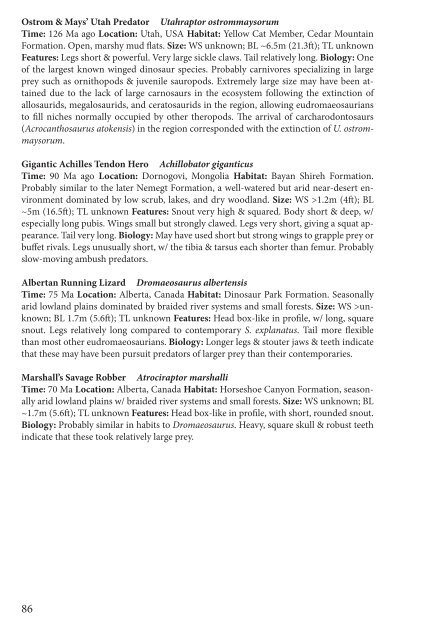You also want an ePaper? Increase the reach of your titles
YUMPU automatically turns print PDFs into web optimized ePapers that Google loves.
Ostrom & Mays’ Utah Preda<strong>to</strong>r Utahrap<strong>to</strong>r ostrommaysorum<br />
Time: 126 Ma ago Location: Utah, USA Habitat: Yellow Cat Member, Cedar Mountain<br />
Formation. Open, marshy mud flats. Size: WS unknown; BL ~6.5m (21.3ft); TL unknown<br />
Features: Legs short & powerful. Very large sickle claws. Tail relatively long. Biology: One<br />
of the largest known <strong>winged</strong> dinosaur species. Probably carnivores specializing in large<br />
prey such as ornithopods & juvenile sauropods. Extremely large size may have been attained<br />
due <strong>to</strong> the lack of large carnosaurs in the ecosystem following the extinction of<br />
allosaurids, megalosaurids, <strong>and</strong> cera<strong>to</strong>saurids in the region, allowing eudromaeosaurians<br />
<strong>to</strong> fill niches normally occupied by <strong>other</strong> theropods. The arrival of carcharodon<strong>to</strong>saurs<br />
(Acrocanthosaurus a<strong>to</strong>kensis) in the region corresponded with the extinction of U. ostrommaysorum.<br />
Gigantic Achilles Tendon Hero Achilloba<strong>to</strong>r giganticus<br />
Time: 90 Ma ago Location: Dornogovi, Mongolia Habitat: Bayan Shireh Formation.<br />
Probably similar <strong>to</strong> the later Nemegt Formation, a well-watered but arid near-desert environment<br />
dominated by low scrub, lakes, <strong>and</strong> dry woodl<strong>and</strong>. Size: WS >1.2m (4ft); BL<br />
~5m (16.5ft); TL unknown Features: Snout very high & squared. Body short & deep, w/<br />
especially long pubis. Wings small but strongly clawed. Legs very short, giving a squat appearance.<br />
Tail very long. Biology: May have used short but strong wings <strong>to</strong> grapple prey or<br />
buffet rivals. Legs unusually short, w/ the tibia & tarsus each shorter than femur. Probably<br />
slow-moving ambush preda<strong>to</strong>rs.<br />
Albertan Running Lizard Dromaeosaurus albertensis<br />
Time: 75 Ma Location: Alberta, Canada Habitat: Dinosaur Park Formation. Seasonally<br />
arid lowl<strong>and</strong> plains dominated by braided river systems <strong>and</strong> small forests. Size: WS >unknown;<br />
BL 1.7m (5.6ft); TL unknown Features: Head box-like in profile, w/ long, square<br />
snout. Legs relatively long compared <strong>to</strong> contemporary S. explanatus. Tail more flexible<br />
than most <strong>other</strong> eudromaeosaurians. Biology: Longer legs & s<strong>to</strong>uter jaws & teeth indicate<br />
that these may have been pursuit preda<strong>to</strong>rs of larger prey than their contemporaries.<br />
Marshall’s Savage Robber Atrocirap<strong>to</strong>r marshalli<br />
Time: 70 Ma Location: Alberta, Canada Habitat: Horseshoe Canyon Formation, seasonally<br />
arid lowl<strong>and</strong> plains w/ braided river systems <strong>and</strong> small forests. Size: WS unknown; BL<br />
~1.7m (5.6ft); TL unknown Features: Head box-like in profile, with short, rounded snout.<br />
Biology: Probably similar in habits <strong>to</strong> Dromaeosaurus. Heavy, square skull & robust teeth<br />
indicate that these <strong>to</strong>ok relatively large prey.<br />
86



